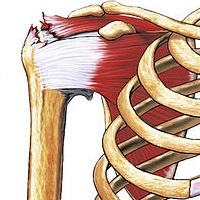
Photo from wikipedia
Objective: The aim of this study was to investigate the effect of the angle between the scapular spine and acromion in the sagittal plane on the location of chronic rotator… Click to show full abstract
Objective: The aim of this study was to investigate the effect of the angle between the scapular spine and acromion in the sagittal plane on the location of chronic rotator cuff tears (RCTs). Methods: The magnetic resonance images of patients who had undergone an arthroscopic shoulder surgery were evaluated. The patients were divided into two groups: patients who had undergone RCT repair and those who had experienced different shoulder surgery as a control group. The RCT group (study group) was then subgrouped in terms of the location of the tear as posterior-superior RCT type 3, 4, 5 or combination (group A) and anterior-superior RCT type 1,2,3 or combination using the Patte sagittal classification (group B). A novel angle, scapular spine-acromion angle (SSAA), was described in the sagittal plane and compared between the groups and subgroups. Results : A total of 96 patients underwent an arthroscopic RCT repair with a mean age of 59.5 years (range, 36-65 years), and the control group was composed of 40 patients with a mean age of 52.5 (range, 41-63 years). Comparison the group B (mean value: 73.41°±5.98°, median: 73,8°, range: 60.6°-89.7°) has significantly higher degrees of SSAA than group A (mean value: 63.92°±6.82°, median: 64,8°, range: 52.3°-77.9°) (P < 0.001). Conclusion : This study demonstrated a higher incidence of posterior- superior RCTs in patients with lower SSAA and anterior-superior RCTs in patients with higher SSAA in the sagittal plane compared to the control group. So sagittal acromial orientation might influence the RCT location.
Journal Title: Acta Orthopaedica et Traumatologica Turcica
Year Published: 2022
Link to full text (if available)
Share on Social Media: Sign Up to like & get
recommendations!